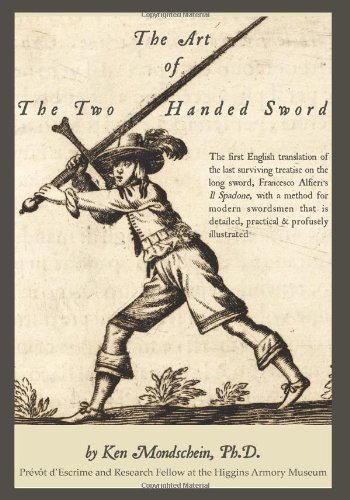Items related to The Art of the Two-Handed Sword

The Art of the Two-Handed Sword translates one of the last surviving works on the use of the two-handed sword, also called the great sword, a Renaissance descendant of the medieval knightly weapon that was equally at home on the battlefield, at tournaments, in the fencing academy, or on the street. The second half of the book provides a clear, practical, detailed guide to its use, as well as to the theory and practice of historical fencing. Francesco Alfieri’s 1653 Lo Spadone (The Two-Handed Sword), translated here, provides a “missing link” between medieval and modern martial arts. It displays clear continuity with both medieval swordsmanship and the still living traditions of sabre and great stick. Beginning in the 14th Century, swords became more sharply pointed in order to pierce the heavy plate armor of the day, and the grip became longer to allow two-handed use for greater power. By the end of the 15th Century, the two-hander, as long as a man is tall, had become a fearsome infantry weapon used to break up pike formations and in honor guards defending the standard or banner. It was also used in tournaments, on the field of honor, and for civilian self-defense. This long two-hander was known in Italy as the spadone. Its basic methods have continued to the present day in great stick technique. The Art of the Two-Handed Sword is the first complete English translation of Alfieri’s book, supplemented by related materials: the MS Riccardiano (c. 1550) and works by Camillo Agrippa (1553), Giacomo di Grassi (1570), and finally Guieseppe Colombani (1711), who provides our last textual reference to the weapon. Alfieri’s work is supplemented by Ken Mondschein’s painstaking reconstruction and adaptation of longsword practice for the present day. He draws on primary sources, martial arts traditions, classical and modern fencing theory, and extensive practical experience to create a practical and enjoyable method for learning and practicing the spadone under modern conditions. Numerous photographs illustrate the techniques that he describes.
"synopsis" may belong to another edition of this title.
About the Author:
Ken Mondschein, a lifelong student of history and the martial arts, received his Ph.D. in medieval history from Fordham University. He is certified as a Prévôt d’Escrime by the International Academy of Arms and holds a second-degree black belt in traditional Japanese karate. He is a historical fencing instructor and Research Fellow at the Higgins Armory Museum, a Visiting Fellow at University of Massachusetts— Amherst Center for Interdisciplinary Renaissance Studies, and a fencing coach at Pioneer Valley Fencing Center. He was a Fulbright grantee to France in 2007–2008 and a visiting fellow at Harvard in 2009–2010. Ken is the translator of Camillo Agrippa’s seminal 1553 rapier treatise (Italica Press, 2009), and The Knightly Art of Battle, a study of Fiore dei Liberi’s medieval martial arts (Getty Publications, 2011), among other works. In all, Ken has almost two decades of martial arts experience, with fourteen years of experience in traditional Western swordsmanship and stick fighting. He is also an experienced equestrian.
"About this title" may belong to another edition of this title.
- PublisherSKA SwordPlay Books
- Publication date2012
- ISBN 10 0978902289
- ISBN 13 9780978902285
- BindingPaperback
- Number of pages230
- Rating
(No Available Copies)
Search Books: Create a WantIf you know the book but cannot find it on AbeBooks, we can automatically search for it on your behalf as new inventory is added. If it is added to AbeBooks by one of our member booksellers, we will notify you!
Create a Want